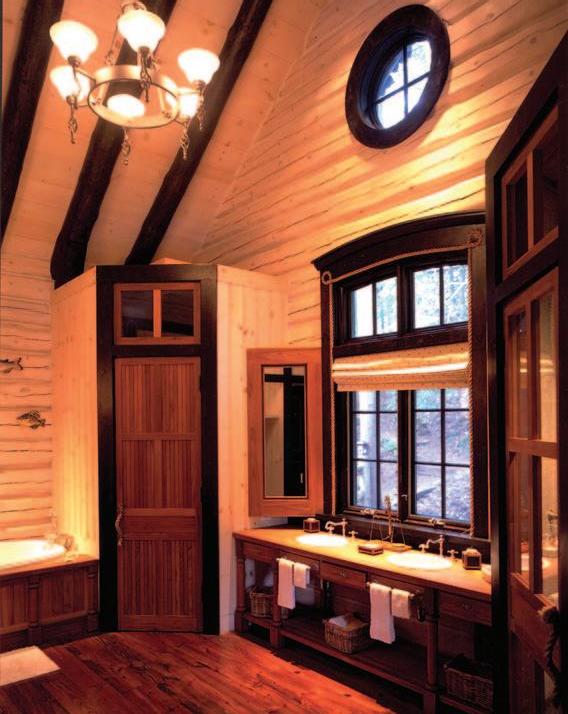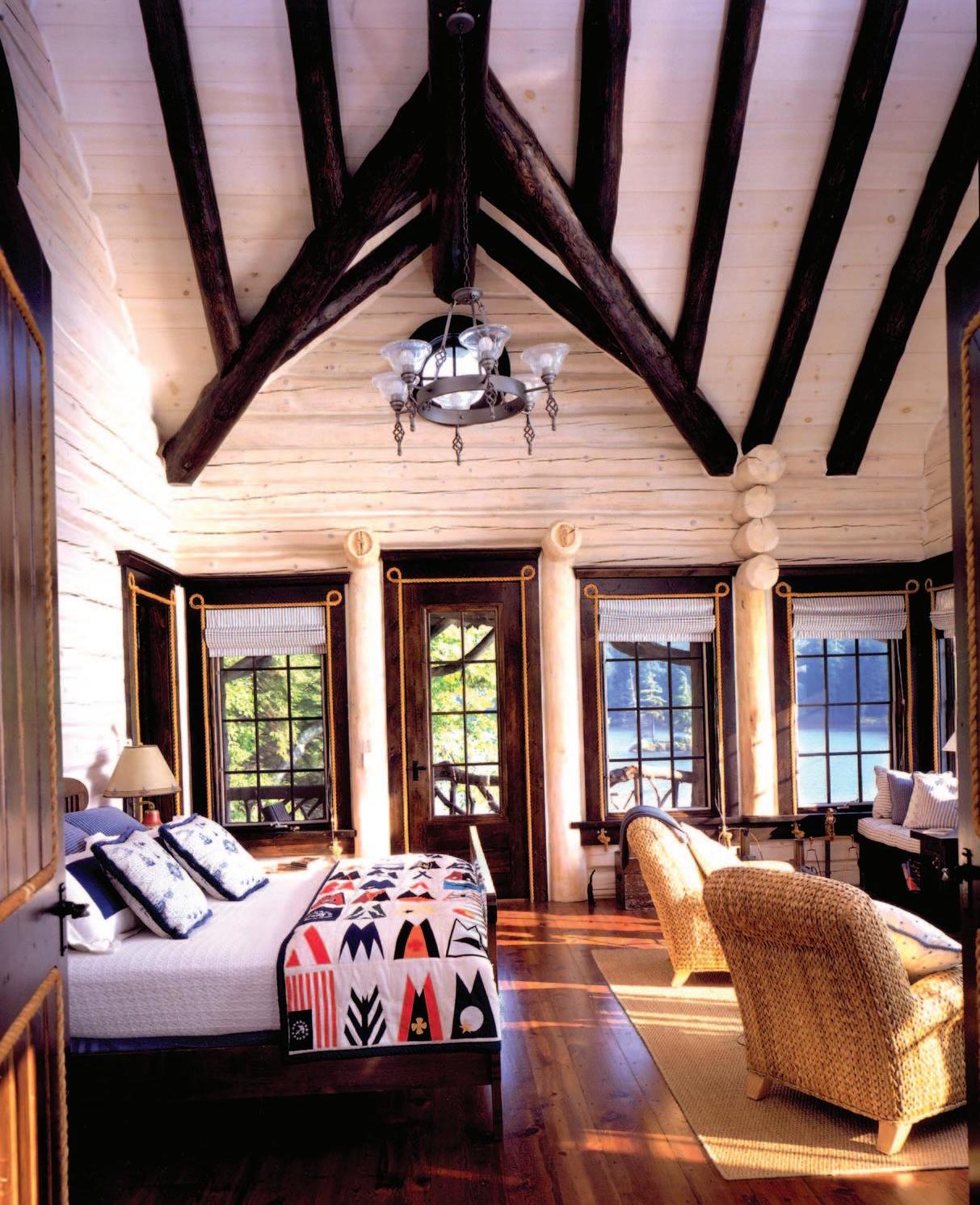
6 minute read
Flashback Fave: Labor of Love
fa flashback ve
May/June 2006
Home COSMOPOLITAN Grand Rapids
A historical renovation by Maple Island Log Homes Labor of L ove
2006: In the early 1920s, heiress to the Post cereal fortune, Marjorie Merriweather Post, chose the scenic banks of New York’s Upper St. Regis Lake as the site to build her own massive and remarkable getaway: Camp Topridge, a Great Camp of the Adirondacks. Over the many decades, this exquisite example of the Adirondack style fell into disrepair ... until the current owner contacted Michigan-based Maple Island Log Homes.
Love Labor of
WRITTEN BY HOLDEN SMITH PHOTOS PROVIDED BY MAPLE ISLAND LOG HOMES C ereal heiress Marjorie Merriweather Post, business-minded philanthropist and art collector. The deep forests and pristine lakes of upper New York state. A Michigan-based log home builder. At first, these three items may seem to have little in common, but they are all linked in one awe-inspiring way: the former Camp Topridge, a Great Camp of the Adirondacks.
The story that brings these seemingly disparate entities together begins at the turn of the last century, when the rich from New York City embraced the wilds of New York state as their personal playground. The pure air, rolling hills and sparkling lakes were a siren’s call for the city-weary wealthy—yet just because they yearned for a taste of the wilderness didn’t mean they were looking to “rough it.” Accordingly, they had fabulous estates built that offered all the comforts they were accustomed to ... but rather than attempting to bring the flavor of the big city to the country, these resorts drew inspiration from and complemented their verdant backdrop. In the construction of these sprawling multi-building complexes, drastic modifications of the existing woodland environment were avoided; buildings were constructed primarily of timber, stone and other natural materials gathered from the immediate surrounding area, then decorated with a rustic—albeit grand—motif. Together, these spectacular north woods retreats gave rise to the Adirondack Great Camp, a style that majestically blends the elegance of the era with rugged natural beauty.
In 1923, heiress to the Post cereal fortune Marjorie Merriweather Post chose the scenic banks of New York’s Upper St. Regis Lake as the site to build her own massive and remarkable getaway. The many incredible features of her Camp Topridge include a grand main lodge, a boathouse accented with tree roots and limbs and an onion-domed structure inspired by the Russian architecture Post encountered while living in the Soviet Union. Today, this breathtaking camp is one of only 10 Adirondack Great Camps on the National Register of Historic Places—yet there was a time when this exquisite example of the Adirondack style fell into disrepair. That’s where Maple Island Log Homes enters into the tale.




Designers and builders of innovative and unique handcrafted log homes, Maple Island Log Homes was hand-picked by the current owner—a Texas real estate magnate—as he undertook the task of rescuing the camp from its dilapidated state and restoring it to its former glory. “This was an opportunity to push the envelope,” says architect Gordon Hughes, now retired from the Twin Lake, Mich.-based Maple Island. “It was an opportunity to try new things and not be restricted on a budget.”
Founded in 1977, Maple Island is a leader in the log home industry; they are unique among builders of log homes in that nearly every step of the process is done by hand. Maple Island’s employees are responsible for handling every part of the construction process, from choosing the logs themselves to the final reassembly on the job site. Whether restoring a national treasure or building a new home, “it starts with the plans—everything we do starts from scratch,” explains Maple Island vice president Eric Gordon.
The logs used by Maple Island are hand-peeled of their bark, a process which brings out the natural grain of the wood. Logs retain their unique “personalities” and are left naturally tapered and full-length, sometimes reaching up to 50 or 60 feet. The selected logs are then skillfully fitted into place by hand. Maple Island’s expertise came into play as they produced new log structures on the property; their sister company, American Log Restoration, was responsible for restoring the original buildings.


Local crafters, architects and historians all collaborated in order assure that the camp would be correctly restored while retaining its original spirit and character. The blending of old and new was not a simple undertaking, says Gordon. “It was a totally different sort of project. You had totally unique structures being worked on by differ- ent entities—an architect in Lake Placid, New York, another in Maryland, and an interior designer in Dallas, Texas.” The architects came to Hughes and Gordon with designs, who in turn worked to express those designs in log construction.
To produce successful results, Maple Island’s team had to work closely with the architects and historians; Hughes recalls many singleengine plane rides from Twin Lake to the Adirondack Camp job site. “I guess it’s somewhat akin to portions of New England; access can be difficult.” In the end, Maple Island was able to blend the historic ele- ments of the camp with new construction, breathing new life into the Great Camp while remaining true to the celebrated Adirondack style. The final result is fantastic, thanks in part to the owner’s desire to “go all-out with everything they did,” says Gordon.
The restored camp is truly a wonder to behold. The boathouse is one of the camp’s most striking designs, featuring a boat launch set into its mammoth split-stone foundation. Being landlocked on a peninsula, all of the materials necessary for the boathouse’s construc- tion had to be taken across the lake by barge before being assembled. Today, lucky guests staying in either of the boathouse’s two wellappointed bedrooms can enjoy the contrasting stains of the interior logs while soaking up views of the glittering lake.
The Russian guest cabin, topped with five massive cedar-shingled “onion” domes, looks every bit like it was appointed for a czar. Designed by Richard Giegengack—whom Hughes describes as a “Frank Lloyd Wright-style genius”—the 24-sided structure features hand-flattened interior walls with the exterior logs left full-round. The melding of the rustic Adirondack style with traditional Russian influences results in one of the most distinctive logbuildings in the nation.
Looking back on the Adirondack Camp project, Hughes calls it unique in both its breadth and scope. “It was an opportunity for us to grow as a company,” he says. “We never knew exactly where it was going. Watching it evolve was exciting.”
Says Gordon, “There were struggles bringing all the voices— architects, historians and craftsmen—together, but the result is one of the truly great camps in the Adirondacks.” ❂












